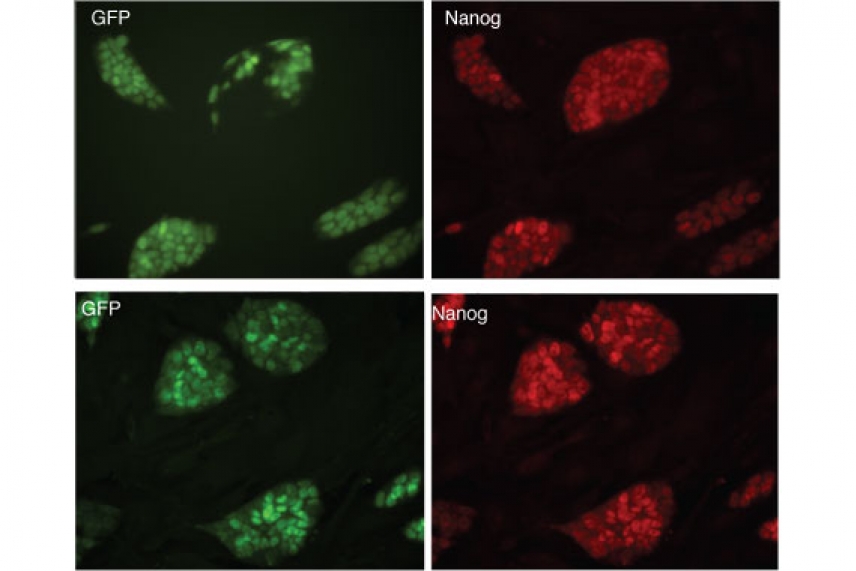Study challenges long-held assumption of gene expression in embryonic stem cells

Top left: Green reporter upstream of Nanog that disables one allele
Bottom left: Green reporter downstream of Nanog gene that keeps both alleles intact
Top and bottom right: Endogenous Nanog protein
Courtesy of Cell Stem Cell and Dina Faddah/Whitehead Institute
CAMBRIDGE, Mass. – Whitehead Institute researchers have determined that the transcription factor Nanog, which plays a critical role in the self-renewal of embryonic stem cells, is expressed in a manner similar to other pluripotency markers. This finding contradicts the field’s presumptions about this important gene and its role in the differentiation of embryonic stem cells.
A large body of research has reported that Nanog is allelically regulated—that is, only one copy of the gene is expressed at any given time—and fluctuations in its expression are responsible for the differences seen in individual embryonic stem (ES) cells’ predilection to differentiate into more specialized cells. These studies relied on cells that had a genetic marker or reporter inserted in the DNA upstream of the Nanog gene. This latest research, published in this week’s edition of the journal Cell Stem Cell, suggests that results from studies based on this approach could be called into question.
To quantify the variations in Nanog expression, Dina Faddah, a graduate student in the lab of Whitehead Institute Founding Member Rudolf Jaenisch, looked at hundreds of individual mouse ES cells with reporters inserted immediately downstream of the Nanog gene. One Nanog allele had a green reporter, while the other had a red reporter, allowing Faddah to determine which of the two alleles was being expressed.
After analyzing the results and comparing them to the expression of a “housekeeping” gene and other pluripotency factors, Faddah concluded that, regardless of the cells’ growing environment, most ES cells express both Nanog alleles and the variability of this expression corresponds to that of the other genes.
When Faddah tested the established method of inserting a reporter upstream of Nanog, her results reflected the earlier studies’ conclusions. However, when she checked the results with other forms of gene expression analysis, she found that the method was not a faithful indicator of Nanog’s expression.
“The way the reporter was inserted into the DNA seems to disrupt the regulation of the alleles, so that when the reporter says Nanog isn't being expressed, it actually is,” says Faddah.
For Jaenisch, this is an instructional tale that should be heeded by all geneticists.
“Clearly, the conclusions for this particular gene need to be reconsidered,” says Jaenisch, who is also a professor of biology at MIT. “And it raises the question for other genes. For some genes, there might be similar issues. For other genes, they might be more resistant to this type of disturbances caused by a reporter.”
This work is supported Vertex Scholars Program, the National Science Foundation (NSF grant 1122374), Jerome and Florence Brill Fellowship, Croucher and Ludwig Research Fellowship, the National Institutes of Health (NIH) (1 F32 GM099153-01A1, HD 045022 and R37CA084198).
* * *
Rudolf Jaenisch's primary affiliation is with Whitehead Institute for Biomedical Research, where his laboratory is located and all his research is conducted. He is also a professor of biology at Massachusetts Institute of Technology.
* * *
Citation:
Faddah, D. A., Wang, H., Cheng, A. W., Katz, Y., Buganim, Y., & Jaenisch, R. (2013). Single-cell analysis reveals that expression of nanog is biallelic and equally variable as that of other pluripotency factors in mouse ESCs. Cell Stem Cell, 13(1), 23-29.
Topics
Contact
Communications and Public Affairs
Phone: 617-452-4630
Email: newsroom@wi.mit.edu


